It seems like a dish for old folks and babies – a softly comforting thick soup, eaten with a spoon. But in fact risi e bisi (pronounced REE-see ay BEE-see) is a classic Venetian dish, traditionally served to the Doge during the spring festival of Venice’s patron saint, St Mark. Though in modern Italy this simple, nutritious dish is happily enjoyed by children and adults alike.
Risi e bisi is a celebration of the tender fresh peas of spring, which I realize will not appear for at least a couple of months. But I’ve been traveling a lot recently to see my mom and dad, and what’s seasonal in my kitchen these days is an empty refrigerator. Scavenging a bag of sweet peas from the freezer and half a box of Arborio rice from the pantry, I was more than pleased with this satisfying meal that filled my vegetable craving and hinted of brighter, warmer days to come.
Soupier than risotto, risi e bisi is also easier to make, without the constant stirring of its fussier cousin. Rice (the same extra-starchy rice as risotto – Arborio is most commonly found in the US, but other varieties include Canaroli or Vialone Nano) is briefly toasted in olive oil with a bit of onion or garlic, then hot chicken stock is added in batches as the rice soaks it up. Peas and Parmesan are casually stirred in at the end.
The traditional method for making this dish starts with a green broth made from the fresh peapods, which would add an extra fresh touch. But with frozen peas, homemade chicken stock is wonderful if you have it (I found a Mason jar of stock in the freezer with the peas); otherwise a good-quality commercial broth will do just fine.
Risotto is normally made with onion, and in keeping with the theme, risi e bisi can also be made with spring onions (scallions). Instead of onion, Rachel Ray uses minced garlic, which I really like also. For this pantry meal, you have the freedom to use what you have on hand.
You’ll need two pots – one for broth and one for the soup. You could also heat your broth in a quart-sized pyrex in microwave, but it won’t stay as hot during cooking.
Here I used a little bacon grease for half the olive oil – you could add pancetta or ham to flavor your risi e bisi as well. I didn’t filter my bacon grease, but you already knew that.
I added my garlic with the rice. Minced garlic burns quickly, and I’m frequently distracted.
Add 1/3 of the broth.
Add more when it gets dry (this is too dry!).
I threw in some Parmesan rinds from my cheese grating.
If the rice has an opaque center, it’s not done yet. But it’s good to taste it anyway if you aren’t sure.
This is done, nice and creamy.
Frozen petite peas cook instantly, turning a fresh bright green. Overcooked peas get dull and sad, which is why we wait until the end for the peas.
Add cheese.
Season well with salt and pepper. Your taste buds know what’s good.
The rice will continue to absorb liquid. Add hot water if it gets too thick. Already this is a little thick. But unless you are cooking for il Doge, you really can’t go wrong.
Risi e Bisi (Rice and Peas)
A classic Venetian risotto-like soup that is both simple enough for children and refined enough for il Doge. Adapted from Rachel Ray.
Ingredients
- 6 cups chicken stock or good-quality chicken broth
- 3 tablespoons extra-virgin olive oil
- 2 cloves garlic, chopped
- 1 1/2 cups (250 grams) Italian risotto rice, such as Arborio, Canaroli, or Vialone Nano
- Salt and pepper
- 12 ounces (about 2 2/3 cups) frozen peas
- 1/2 cup grated Parmigiano-Reggiano or Pecorino Romano cheese
Directions
- Place chicken stock in a small pot and warm over low heat.
- Heat a medium saucepan over medium heat. Add extra-virgin olive oil, garlic and rice.
- Toast the Arborio rice for a minute or two, then ladle in 1/3 of the stock.
- Bring to a bubble. Stir rice occasionally, allowing the rice to get starchy and absorb the liquid. Add more stock when rice starts to become dry. Continue stirring and ladling broth until rice is al dente, about 22 minutes. Use hot water to loosen the mixture if you run out of stock. The rice when done should be soupier than risotto.
- Stir in peas and cheese and season well with salt and pepper to taste. Serve immediately.
Notes
- Feel free to substitute 1/4 cup scallions, yellow onion or shallots for the garlic.
- When buying fresh peas in pods, you’ll need twice the weight as frozen shelled peas.
- If you are using fresh peas: shell and set aside; boil peapods in lightly salted water to make peapod broth to use instead of chicken broth.
- Optional add: 1/4 cup pancetta or ham with the olive oil and garlic, then add rice.
- For vegetarian version, use vegetable broth or peapod broth.
- Soup will become very thick when refrigerated. When reheating, add water to desired consistency.
Here’s the link to a printable version.

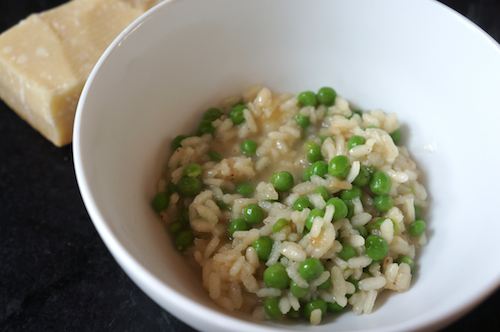
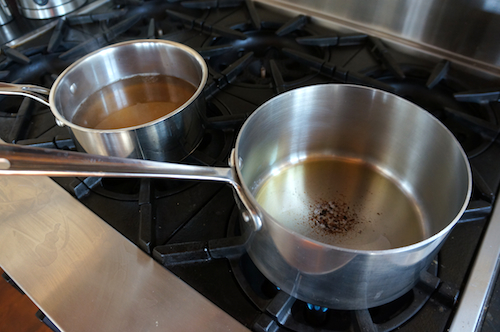
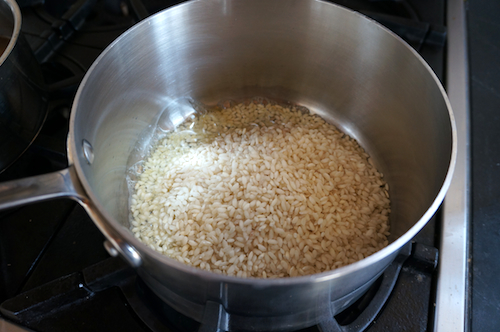
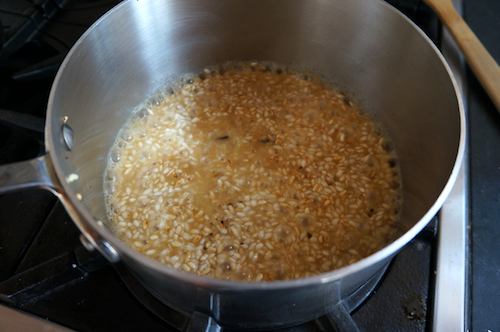
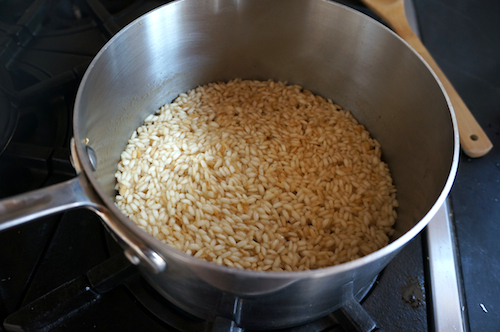
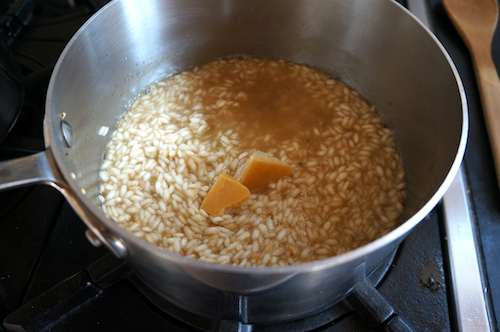
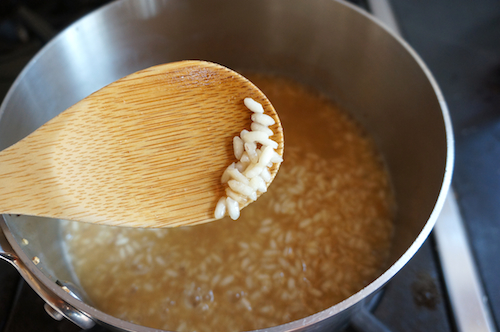

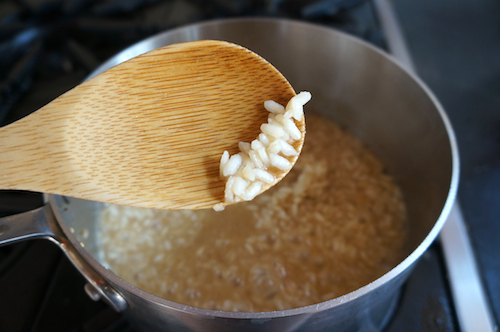
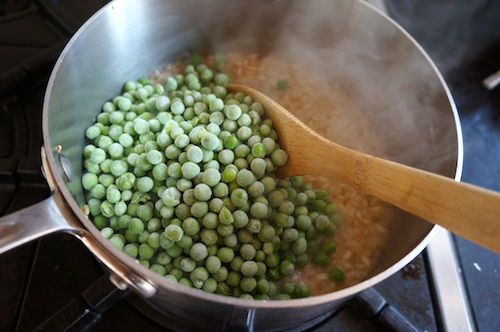
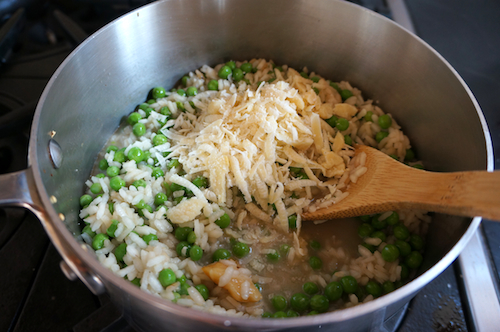





I have been making a risi bisi that would probably horrify Venetians for years based on Barbara Kafka’s microwave technique. The beauty of it is that you don’t have to stir it–microwave does it all. You can find it here:
http://libraryladycooks.blogspot.com/2011/02/recipes-revisited-risi-bisi-gets-even.html
Came across your blog when looking for more hamantaschen fillings. I too use Marcy Goldman’s recipe, with a few tricks of my own!
hi library lady – thanks so much for sharing! microwave method sounds really convenient. i’ll have to check out your hamantaschen tricks! it’s that time of year again, yum. =)
And this is the year I learned to do the “pinwheel” style of folding, which keeps the filling from leaking out. Each side has one corner tucked in, and one corner lifted over. Worked like a charm. Now if I could just figure out what happened to that batch of prune filling I made….